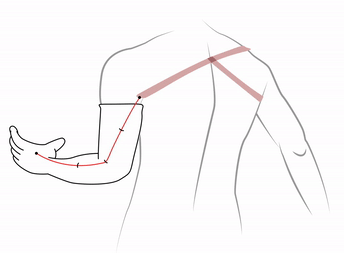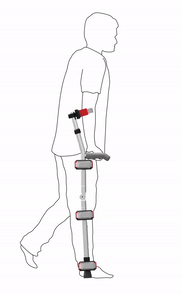walking stick
A MECHANICAL WALKING AID THAT USES HAND MUSCLE POWER FOR LEG MOVEMENT.
Product Design, User testing
What is WALKING STICK?
The walking aid, a stick that translates user's hand muscle power for leg movement. It can be used for problems like short foot, foot amputation, ligament tear, fracture, knee pains and more.
Market Problem
When one breaks a bone in their leg or foot, have a procedure on their knee or lower leg, or suffer a stroke, the doctor would recommend to use a walking aid while one is healing or recovering.
A crutch becomes necessary when a person cannot walk or walks with extreme difficulty. Any person with leg or foot pain or injury, weak muscles, or an unstable gait may benefit from using a crutch or crutches. Using crutches, a cane, or a walker can help keep your weight off your injured or weak leg, assist with balance, and enable you to perform your daily activities more safely. If ones injury or surgery requires them to get around without putting any weight on their leg or foot, they may have to use crutches.
There are different types of crutches or walking aids; Under Arm or Axilla, Forearm crutch, Platform Walking Aid, Leg Support aid and walking sticks or Canes.
MArket
According to the Census 2001, 2.1% (21 million) of total population in India are disabled.
The National Sample Survey Organization - 2002 estimated that 75% of people with disabilities live in rural areas.

inspiration
A transhumeral prosthesis for a person with upper limb amputation works on a cable which is connected to the belt, worn across the shoulder. The muscle power of the shoulder is transferred through a system to the wrist.
Can we transfer the hand muscle power through a system to leg and the person is able to walk properly?

concept
The crutch is divided into 3 different parts the hand unit, the thigh/knee unit and the base unit. This allows the adjustment of the height at 3 different places. a) Based on the length of arm, b) Based on the length between knee and hip, and c) Based on the length of the knee to foot.
Part1 - The hand unit - This unit comprises of a hand strap, a handle same as one found in a regular crutch, and a thigh strap attached on the rod below the handle.
Part2 - The Thigh/Knee unit - This unit comprises of a knee joint and knee strap. The knee joint is adjusted in the direction of walking the pivots only in one direction imitating the cycle of a knee when person is walking.
Part3 - The Base unit - This is the base attachment which goes inside the thigh/knee unit. This is a modular base attachment depending upon the type of disability. For example, for short foot the attachment will be different compared to a foot drop related attachment, compared to a regular attachment. There are different types of attachment that goes into the base of this main stick unit.

Advantanges
This can be primarily be helpful to following different functions:
a) Helps a patient when they have to train on new prosthetic leg, post amputation. Currently, the patient has to go to a physiotherapist on a daily basis for 1 to 2 hours for his regular walking practice for 4 to 6 months depending upon the type of amputation. This product helps the patient to exercise walking at home and not go to the physiotherapist daily but once in 15 days saving time and money.
b) It reduces the efforts made in walking by the polio patients. The polio affected patients based on severity walk in different ways. Some with crutches, crutches and callipers, hunch back etc., the stick solves the problem by making the user walk straight and independently.
c) As a replacement of leg braces and crutch. People with problems of weak knew, weak ankle, legs turning inside or outside due to weak hip muscle.
d) Its discards the use of a 4 legged walker or 2 crutches in cases of fracture, short leg, paralysis and foot amputation.


Ergonomically Friendly
Compatible for size range of 25th percentile female to 75th percentile male.

Product Adaptibility
To reduce the manufacturing cost same stick can be worn on both the legs by rotating the strap by 180 degrees.


User Testing
User testing was done at various disability centers in Gujarat, India.

Walk Cycle

The design of the stick is such that the base of the stick can be removed and different attachments according to the needs of the user like foot drop, short foot, foot amputations, etc can easily be attached to the same stick.